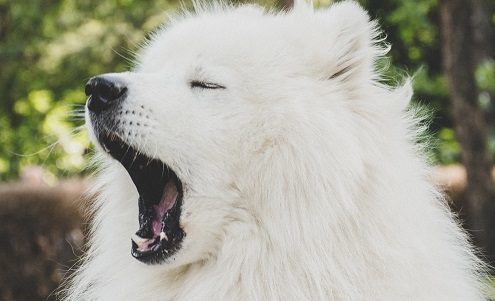We are used to hearing about flu vaccines and influenza for humans, but what about dogs – can our precious pups also get the flu?
Unfortunately, yes, dogs can experience canine influenza.
If you think your pup may have this illness, which has also been dubbed “dog flu”, review this guide to discover the canine influenza symptoms and signs. In that event that it appears your dog has this or another condition, we do recommend reaching out to your trusted veterinary professional. They will be able to assess your dog’s unique situation and outline the most accurate steps to follow.
With that being said, let’s provide more details into the signs of canine influenza.
What is Canine Influenza?
This dog flu is a virus that infects a canine’s respiratory system. It is in a similar category of the virus that causes human influenza, however, dog flu does not appear to affect humans.
The origin of canine influenza is not definite, but there are strong ideas. One theory is that canine influenza started as a horse virus that mutated and, in fairly recent history, began to affect racing greyhounds. From the greyhound dogs, it would have trickled out and affect other canines.
Are There Multiple Types of Dog Flu?
Yes, there are two kinds of influenza virus that your dog may contract, CIV H3N8 or CIV H3N2. The flu can be either mild or severe, but the initial symptoms and signs are similar.
CIV H3N2 is the strain that typically shows up as more severe. It first popped up in the United States around 2015 amid a respiratory outbreak in Chicago, Illinois. The other, more mild strain (CIV H3N8) was originally identified in America in an early year, 2004.
Since its emergence, it has been studied to find out more about its level of susceptibility, what symptoms it causes and ways to treat it.
Is Canine Influenza Contagious?
 Yes, canine influenza is very contagious. Although, it is interesting to note that some dogs can be exposed and not show symptoms while others show symptoms and become quite sick. Typically, the virus is transferred via respiratory secretions which are usually in the form of sneezing or coughing. It can also come from contact with saliva or secretion of an infected animal.
Yes, canine influenza is very contagious. Although, it is interesting to note that some dogs can be exposed and not show symptoms while others show symptoms and become quite sick. Typically, the virus is transferred via respiratory secretions which are usually in the form of sneezing or coughing. It can also come from contact with saliva or secretion of an infected animal.
One reason most dogs appear to be so susceptible to the virus is that it is such a new disease. With limited or even zero level of exposure, their doggy immune systems are not equipped for fighting it off.
Some places it can happen more easily are:
- Doggy daycare
- Dog training
- Parks or dog beaches
- Walks in which he encounters other dogs
- Human hands.
Because, according to research, it’s been shown that:- Surfaces can host the virus for as long as 2 days
- When contacted via human hands, the virus can live as long as 12 hours
- So if someone pets an infected dog at 11 am and cuddles with their own pup at 6 pm, alas, ii that virus is still there, it could hop to their own pup.
To confirm, however, it is not shown to be contagious to humans. It appears that it only transfers to other dogs.
Canine Influenza Symptoms
There are different signs that can show up in varying degrees in different types of dogs. Some of the symptoms may include:
- Having a cough
- A runny nose
- An overly dry nose
- Goopy discharge from your pup’s eyes
- Fever
- Fatigue
- Decreased appetite
- Their refusal to drink water
- Continual sneezes or wheezing
- Having trouble breathing
How Long Does It Last
Similar to humans in this day and age, the flu is typically not lethal for dogs. (Luckily. Back in the day, it was much more dangerous for humans!) Usually, the effects of the virus last a few weeks. It may not be the most pleasant experience, but it usually does pass.
How to Prevent Dog Flu
 Whether your pup does indeed have canine influenza or not, you want to prevent any future cases. Here are some specific ways to decrease the chances of your dog getting this virus in the future.
Whether your pup does indeed have canine influenza or not, you want to prevent any future cases. Here are some specific ways to decrease the chances of your dog getting this virus in the future.
Wash Your Hands After Petting Other Dogs.
The virus may not affect you, but humans can still transmit the virus through direct contact. (Up to 12 hours it can stay on your skin, remember?) If you pet another dog, no matter how cuddly or adorable those big eyes are, wash your hands before petting your own pup.
Choose Your Doggy Daycare Wisely
Be direct and ask that facility about what has been going on. If there have been dogs there with influenza recently, it’s better to hold off or take them elsewhere. Better safe than sorry.
What If Your Dog Has Canine Influenza?
In the event that your pup has the dog flu, the treatment is similar to a human. Lots of rest. Support. Viruses usually need time to do their worst before they pass.
Do be mindful of where your own dog goes or comes into contact with. Your friend comes over who has a dog? Remind them not to pet your pup. Try not to take them to the park or daycare, so you can limit the spread to any other dogs.
To provide further protection to your dog now or in the future, talk to your vet professional about what shots your dog needs.
Sources:
Naviglia, Nicole. “Dog Flu Outbreak Is On The Rise: Beware These 6 Symptoms.” CanineJournal.com, 1 July 2018, Accessed 14 Oct. 2018. www.caninejournal.com/dog-flu-symptoms/.
“What You Need to Know About Canine Influenza (Dog Flu).” Canine Influenza FAQ: What You Need to Know | Zoetis Inc., Accessed 14 Oct. 2018. www.o.zoetisus.com/BIOS-CIV-Questions.html.
“Dog Flu.” PetMD, Accessed 14 Oct. 2018. www.petmd.com/dog/conditions/respiratory/c_dg_canine_influenza.
“Disease Risks for Dogs in Social Settings.” Avma.org, Accessed 14 Oct. 2018. www.avma.org/public/PetCare/Pages/Disease-Risks-for-Dogs.aspx.




